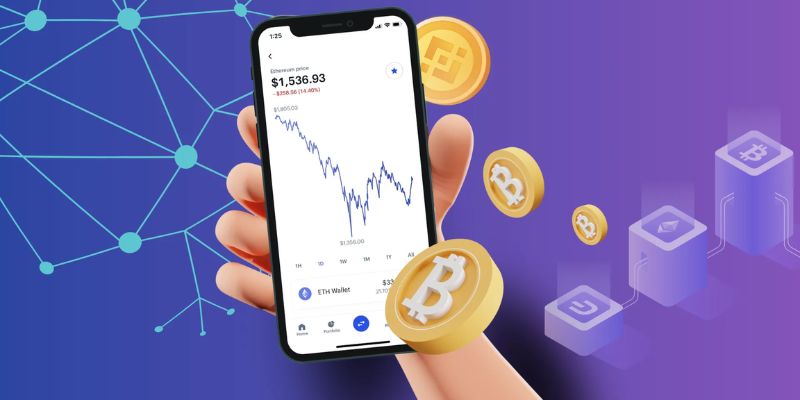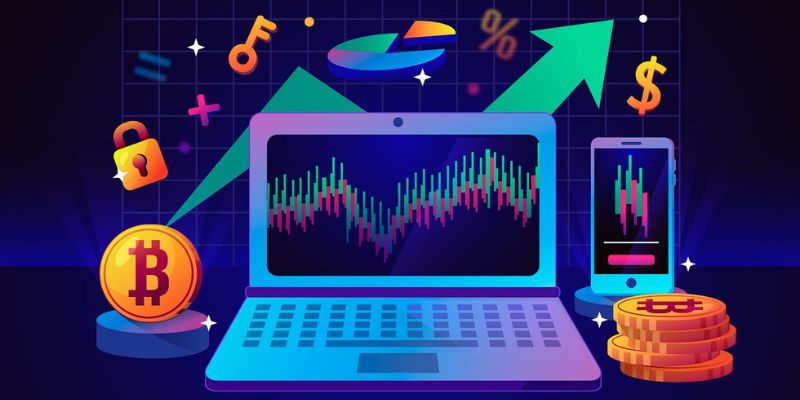Diving into crypto can feel like you’re lost in a maze. You’ve heard the buzz and you’re ready to jump in, but let’s face it—setting up your first crypto wallet setup guide for beginners can scare off even the brave at heart. But fear not! As your guide, I’m here to make this as simple as pie. With my help, you’ll cut through the jargon, learn the types of wallets available, and securely manage your digital treasure like a pro. Ready to take control of your crypto journey? Let’s break down those walls and unveil the power of crypto wallets, step by easy step.
Understanding Cryptocurrency Wallet Types
Comparing Hot Wallet vs. Cold Wallet
When you start storing digital money, you’re faced with a big choice. Do you go for a hot wallet or cold wallet? These terms can sound confusing but don’t worry, we’ll make it simple.
Hot wallets connect to the internet. They are great for quick access and easy transactions. You can think of them like your wallet in your pocket. They’re handy, but since they’re online, they can be at risk, just like your wallet could be stolen from your pocket.
On the other hand, cold wallets are offline. They’re like a safe in your house. They are very secure because they are not connected to the internet. Hackers can’t access them online. But they can be less convenient if you want to use your crypto often.
So what should you pick? If you need to move your crypto often, a hot wallet might be better. But if you want maximum security and don’t need to access it all the time, go with a cold wallet.
Non-Custodial vs. Custodial Wallet Solutions
There’s more to wallets than just hot and cold. You must also pick between non-custodial and custodial wallets. But what do these words mean?
Non-custodial wallets mean you have control. You’re like the captain of your ship. You have the keys, and no one else can move your crypto without them. This type gives you lots of power, but also a lot of responsibility.
Custodial wallets mean a company holds your crypto for you. It’s kind of like a bank holding your money. They take care of the security for you. It’s great for newcomers who are still learning. But remember, if they have problems, your crypto might be at risk.
Most experts would tell you that having control is better. So, a non-custodial wallet might be the better choice. You just need to make sure you can handle the keys and not lose them.
Now, don’t stress out! Each step you take brings you closer to becoming a secure and savvy holder of digital currency. Just weigh the pros and cons of these wallet types, and you’ll be on the right track. And remember, no matter which route you go down – hot or cold, custodial or non-custodial – understanding how to keep them secure is the key. Stay tuned for more on how to do just that!
Setting Up Your First Digital Wallet
Choosing the Right Wallet for Your Needs
Picking out your first digital wallet can feel like a maze. You’ll want a secure spot for your digital coins. Think of your needs. Will you trade a lot, or just a few times? Do you need quick access to your coins? Your answers matter a lot. Now, let’s untangle this together.
You’ll hear about ‘hot’ and ‘cold’ wallets. Hot wallets connect to the web. They’re always ready, and you can trade fast. But since they’re online, they face more risk. Cold wallets, on the other hand, stay offline. They’re like safe boxes for your crypto. Hackers can’t reach them easily. But, they’re not as quick to access as hot wallets.
For daily use, a mobile or desktop wallet works great. They’re software wallets – apps or programs you can install. They’re often free and secure enough for casual users. Mobile wallets ride along in your pocket, making payments easy as pie. Desktop wallets sit on your computer, giving you more control and features.
But, if security is your top concern, get a hardware wallet. Think of it as a high-tech USB stick that locks away your coins. They’re harder to set up, but hackers have a tough time cracking them.
Now, what about trying many kinds of coins? Then a multi-currency wallet is your friend. They let you manage different coins without breaking a sweat. Bitcoin, Ethereum, or others, you can keep them all in one place.
Step-by-Step Digital Wallet Setup Steps
Let’s get to work and set up a wallet. It’s not rocket science, promise. First, decide if you’ll go for a software or hardware wallet. Software means downloading an app or program. Hardware means buying a special device.
Got a software wallet, like a mobile or desktop app? Here’s what to do:
- Download the app or program.
- Open it and create a new wallet.
- Pick a strong password that’s hard to guess.
- Write down your seed phrase. It’s a bunch of words that can save your wallet if things go bad. Keep it secret and safe.
- Encrypt your wallet if the option’s there. It’s one more lock on your crypto treasure.
- Set up two-factor authentication. It’s like a guard that checks both your password and a code from your phone.
For hardware wallets, it’s a bit different:
- Buy from a trusted maker.
- Plug it into your computer.
- Use their guide to start. It might take more steps, but safety’s worth the effort.
- Write down your seed phrase. Yes, it’s that important.
- Keep it unplugged and stashed away when not in use.
Remember, the real trick to a digital wallet is keeping your keys and seed phrases locked down. Without them, getting your coins back is almost impossible. But get them right, and you’ve nailed it. Welcome to the crypto club!
Ensuring the Security of Your Crypto Assets
Private Key Safeguarding and Seed Phrase Security
When you jump into the world of crypto, think of your private key as the magic key to your kingdom. You must keep it safe at all costs. It’s a long string of letters and numbers that lets you get to your coins. It’s like a super-secret password that only you should know.
Now, about your seed phrase: it’s a list of words created when you set up your wallet. If you lose your wallet or forget your password, this phrase is your safety net. It lets you get back into your account. So write down your seed phrase and hide it well. Imagine it’s a treasure map that leads to your crypto fortune. You wouldn’t want it falling into the wrong hands, would you?
The Essentials of Wallet Encryption and Two-Factor Authentication
Let’s talk about keeping bad guys away from your digital riches. One way to do that is with encryption. It scrambles your wallet info so that only someone with the right key can read it. Think of it like turning your wallet into a secret code that only you can crack. It’s a shield that protects your coins.
Then there’s two-factor authentication, or 2FA for short. This adds an extra step to log in to your wallet. It’s like having a guard who double-checks that it’s really you trying to get in. They might ask for a code from your phone or make you answer a secret question. With 2FA, even if someone knows your password, they can’t get in without the second code.
So, when it comes to crypto, being safe is a big deal. Encrypt your stuff, set up 2FA, and your digital cash will thank you! Remember, a small step like 2FA can make a huge difference in keeping your crypto out of reach from hackers. And isn’t that peace of mind what we all want?
Executing Transactions and Managing Your Wallet
Initiating Crypto Transactions and Address Verification
Have you ever needed to send cash fast? In the world of crypto, it’s quite simple. First, you need the receiver’s public address. Think of it like their account number. To send crypto, access your wallet and choose “send”. Enter their address and the amount. But wait – always double-check the address!
Why double-check the address? Well, sending crypto is final. It’s like mailing cash; once it’s gone, it can’t come back unless the other person sends it back. Missteps mean your funds could be lost. So, we verify every digit. Some wallets have a QR code feature. This lowers the chance of mistakes. Scan the code, and the right address pops in.
What if you’re on the receiving end? Pick “receive” in your wallet to show your address. Again, verify all details before sharing. Misspelled addresses could send your funds into the abyss.
The Wallet Backup and Recovery Process
Now, let’s talk safety nets. What if you lose your phone or forget your wallet password? The world doesn’t end if you set up a backup. Start by writing down your seed phrase. It’s a list of words given when you first create your wallet. Keep these secret and safe; they’re the keys to your digital cash kingdom.
Why is a seed phrase important? These words are the master key. Lose everything else but have your seed phrase, and you can still get your funds back. Without it, your crypto could be gone forever if disaster strikes.
To back up, jot down your seed phrase on paper. Some use metal backups to protect against fire or water damage. Practice restoring your wallet with your seed phrase in a safe environment. It’s the best way to be sure you’re ready for real-world surprises.
Remember, if someone gets your seed phrase, they can access your funds. Guard it as if it’s your most precious treasure. Never share it online or store it unencrypted on your computer or phone.
And for an extra layer of armor? Two-factor authentication. Set this up and even if someone knows your password, they can’t get in without your phone or other secured device.
Executing crypto transactions and managing your wallet doesn’t have to be daunting. By understanding how to initiate transfers, double-checking addresses, backing up your precious seed phrase, and employing solid security measures, you can navigate the blockchain with confidence. Keep learning and practicing, and you’ll be sending and receiving crypto like a pro in no time.
In this post, we dove into the world of crypto wallets. We looked at hot and cold ones, plus non-custodial and custodial choices. Next, we talked about picking a wallet that fits you and how to set it up. Then, we covered how to keep your crypto safe, focusing on key phrases and security steps like encryption and two-factor authentication. Lastly, we went through doing crypto trades and how to backup your wallet.
It’s vital to pick a wallet that matches your needs and to keep your crypto secure. Remember these tips and you’ll manage your crypto like a pro in no time!
Q&A :
How do I get started with setting up a crypto wallet?
Setting up a crypto wallet can be a straightforward process even for newcomers. Begin by researching different types of wallets, such as hardware wallets for maximum security, or software wallets for convenience. Once you’ve chosen the type that suits your needs, you need to download the appropriate wallet software or app, or purchase a hardware wallet. After installing or setting up your wallet, be sure to secure it with a strong, unique password and backup your private keys or recovery phrase in a safe place.
What are the key steps in creating a crypto wallet for beginners?
Creating a crypto wallet involves several key steps to ensure your digital assets are secure. Firstly, decide on whether you want a hot wallet (connected to the internet) or a cold wallet (offline storage). Then, select a reputable wallet provider and download the software. During the setup process, you will generate a new wallet, create a strong password, and receive a private key or seed phrase, which you should keep confidential and secure. Finally, test your wallet with a small transaction to ensure everything is working correctly.
What is the safest way to store my cryptocurrency?
The safest way to store cryptocurrency is by using a hardware wallet, which stores the user’s private keys in a secure hardware device, making it highly resistant to online hacking attempts. It’s crucial to purchase hardware wallets from official and reputable sources. Additionally, you should keep the backup of your recovery phrase or private key in a secure location, such as a safe or safety deposit box, and consider using a multisignature wallet that requires multiple keys to authorize a transaction for extra security.
How can I secure my crypto wallet?
Securing your crypto wallet is essential to prevent unauthorized access and theft of your funds. Always use a strong and unique password for your wallet, and avoid sharing it with anyone. Engage two-factor authentication (2FA) if available. Regularly update your wallet software to the latest version for enhanced security measures. Most importantly, keep a backup of your private key or seed phrase in multiple secure locations, and consider using hardware wallets for substantial amounts of cryptocurrency.
Are there any costs associated with setting up a crypto wallet?
Generally, setting up a crypto wallet itself is free, especially if you’re using a software wallet. However, there may be costs associated with purchasing a hardware wallet, which is recommended for added security if you’re handling a significant amount of cryptocurrency. Additionally, when you conduct transactions, the blockchain network will require transaction fees, which are not associated with setting up the wallet but are part of the ongoing use of your digital assets. These fees vary depending on the network congestion and the cryptocurrency in question.



